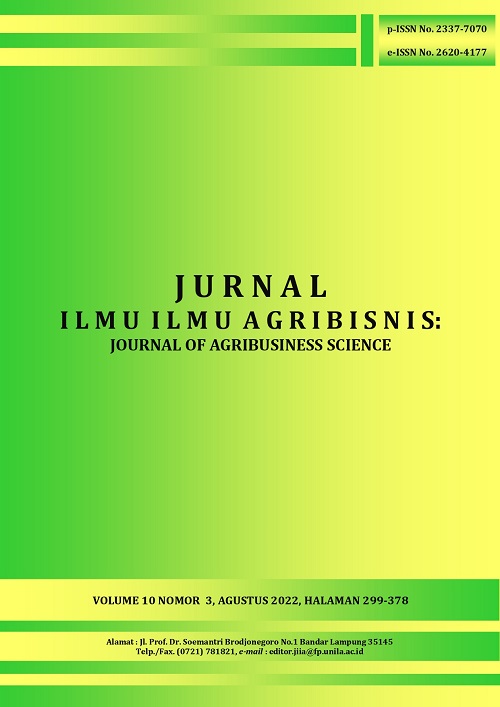ANALISIS PRODUKSI DAN PENDAPATAN USAHATANI UBI KAYU DI KECAMATAN SEPUTIH BANYAK KABUPATEN LAMPUNG TENGAH
DOI:
https://doi.org/10.23960/jiia.v10i3.6218 Abstract View: 700
Abstract View: 700
Abstract
The purposes of this study are to analyze factors that influence cassava production, the cost structure of cassava farming, and the amount of cassava farming income in the Seputih Banyak District, Central Lampung Regency. The determination of the location of the research was carried out intentionally in the District of Seputih Banyak in Central Lampung Regency. Respondents in this study were 70 cassava farmers. This research was conducted in October 2019. This research method uses a survey method. Data were analyzed using the Cobb-Douglas production function, farm income by calculating Revenue Cost Ratio (R/C), and cost structure. The results showed that the factors that significantly affected cassava production and gave positive values were seeds and labor, and the factor that gave negative value was urea fertilizer. The cost structure incurred for variable costs is higher than fixed costs, with the largest total cost structure being the labor cost of 38.56%. The biggest cost structure for cash costs and calculated costs is 56% of non-family labor costs and 92% of land rent. Cassava farming is profitable with income from the total cost of IDR11,799,517 per hectare, and R/C value over total cost of 1.67.
Downloads
Downloads
Published
How to Cite
Issue
Section
License
Authors who publish with this journal agree to the following terms:
Authors retain copyright and grant the journal right of first publication with the work simultaneously licensed under a Creative Commons Attribution License that allows others to share the work with an acknowledgement of the work's authorship and initial publication in this journal.
Authors are able to enter into separate, additional contractual arrangements for the non-exclusive distribution of the journal's published version of the work (e.g., post it to an institutional repository or publish it in a book), with an acknowledgement of its initial publication in this journal.
Authors are permitted and encouraged to post their work online (e.g., in institutional repositories or on their website) prior to and during the submission process, as it can lead to productive exchanges, as well as earlier and greater citation of published work (See The Effect of Open Access).














